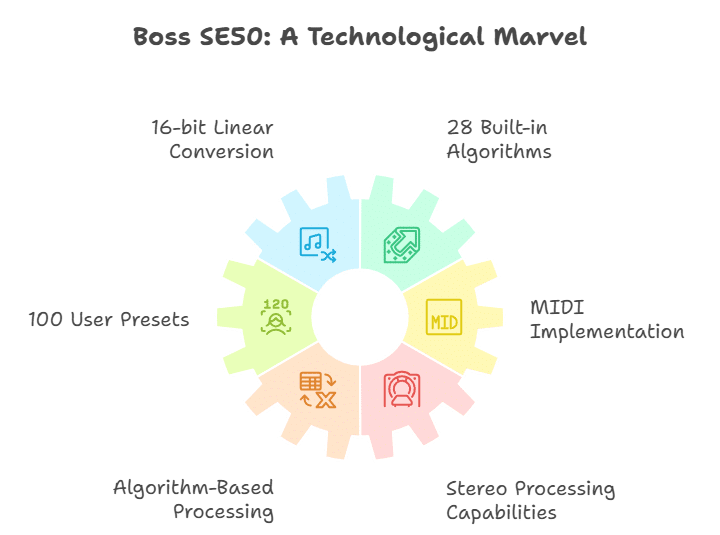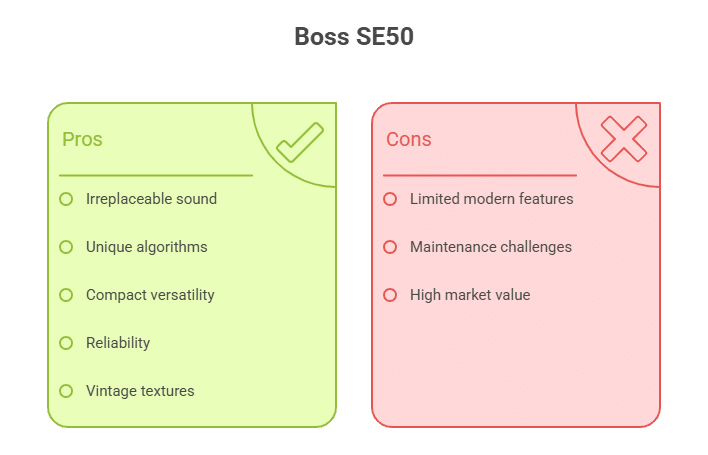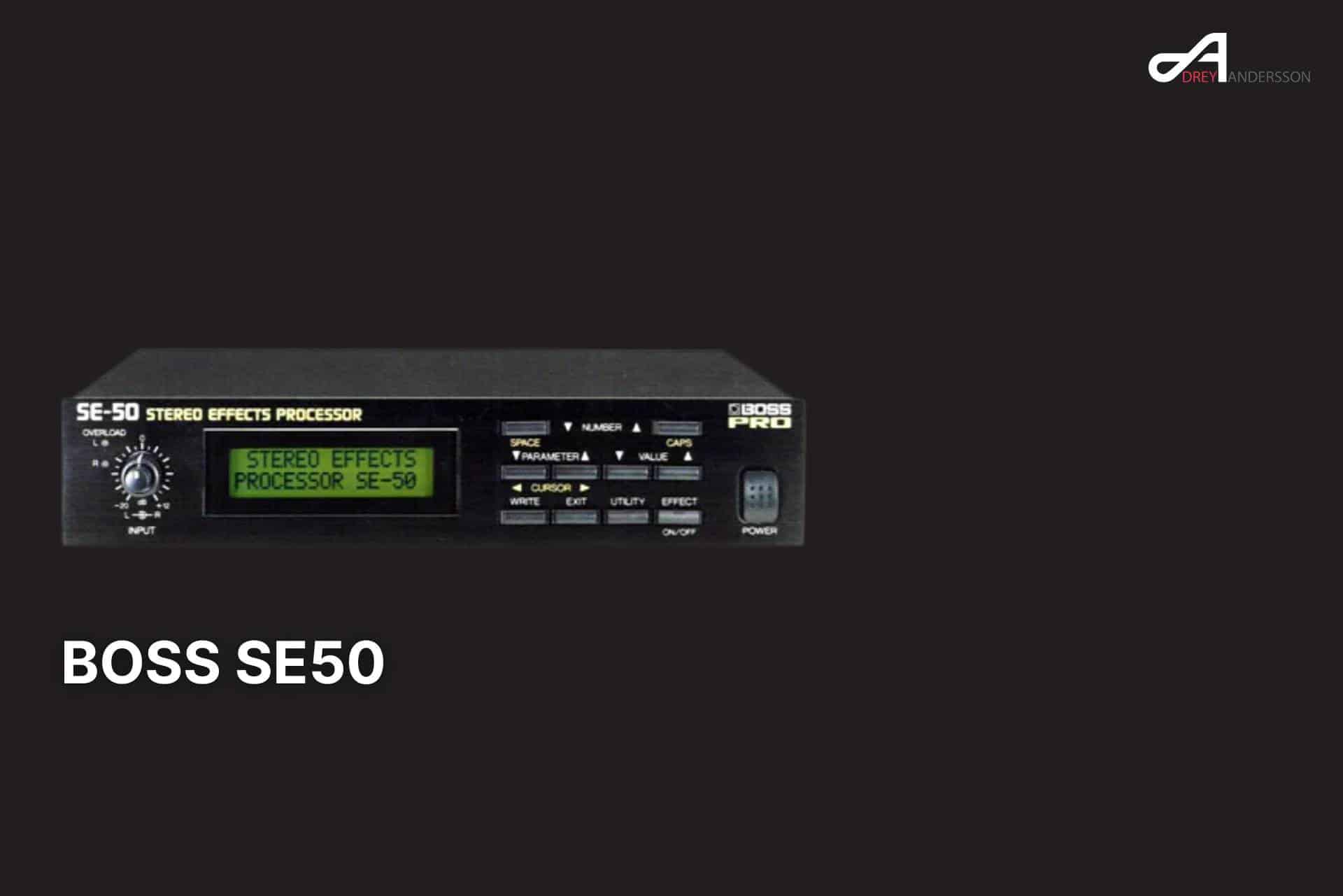The Boss SE50 Stereo Effects Processor stands as one of the most influential and beloved vintage effects units of the 1990s, earning its reputation as the "Swiss Army Knife of multi-effects" through a combination of distinctive sonic character, innovative design, and remarkable versatility in a compact format. Released in 1990 and produced until 1993, this pioneering half-rack digital effects processor democratized professional-quality effects processing and continues to be sought after by musicians and producers who value its irreplaceable vintage character over clinical perfection.
Technical innovation in a compact package
The SE50 represented a significant technological achievement when it debuted in 1990, offering 16-bit linear conversion with variable sampling rates of 32kHz or 48kHz depending on the algorithm. This half-rack unit packed 28 built-in algorithms covering everything from multiple reverb types to complex multi-effects chains, all controllable via 100 user presets with full MIDI implementation. The unit’s physical design prioritized portability and studio integration, featuring stereo 1/4" TRS inputs and outputs, a backlit LCD display, and external 12V DC power operation.
What made the SE50 technologically groundbreaking was its algorithm-based processing architecture. Rather than offering individual effects that users could chain arbitrarily, Boss created optimized effect combinations like the comprehensive "Guitar Multi" algorithm (Compressor → Overdrive/Distortion → Equalizer → Noise Suppressor → Delay → Chorus → Reverb → Line Driver) and specialized processors like the 7-band vocoder and multi-pitch shifter with ±2 octave range. This approach maximized the unit’s limited processing power while ensuring each algorithm delivered professionally usable results.
The SE50’s stereo processing capabilities were particularly advanced for its time, offering true stereo effects processing rather than simple mono-to-stereo conversion. Effects like the Stereo Delay, Stereo Phaser, and Stereo Flanger provided the kind of spatial imaging that was typically only available in much more expensive rack units.

Revolutionary market positioning and lasting influence
Boss positioned the SE50 as an entry-level professional effects processor, bridging the gap between consumer pedals and high-end studio gear. At its original retail price of approximately $500, it competed directly with the established Yamaha SPX90 while offering significantly more versatility than single-effect units and greater affordability than premium processors like the Lexicon PCM70, which cost over $2,000.
The SE50’s impact on music production was immediate and lasting. It arrived during a crucial period when digital effects were transitioning from novelty to necessity, and home recording was emerging as a significant market. The unit’s compact size, comprehensive feature set, and professional sound quality made it an essential tool for bedroom producers and project studios throughout the 1990s.
This democratization of professional effects processing helped establish the modern multi-effects processor market and influenced countless competing designs. The SE50’s success demonstrated that musicians would embrace digital effects if they offered genuine musical value rather than just technical specifications.
The distinctive SE50 sound and sonic character
What truly sets the SE50 apart from both its contemporaries and modern alternatives is its distinctive sonic character. Users consistently describe the SE50 as having a "gritty" and "noisy" quality that adds character rather than detracting from it. This inherent noise floor, described as having "noise/dirt going on," contributes to its vintage appeal and warm, analog-like character despite being fully digital.
The unit’s pitch-shifting capabilities are legendary among users. The SE50’s pitch shifting algorithms create "very special" sounds when used with extreme transposition on drum loops, effects that even its successor, the SE70, cannot replicate. This unique character has made it invaluable for electronic music producers seeking sounds that simply cannot be achieved with modern digital effects.
The SE50’s chorus and phaser effects are consistently praised, with users noting "insane stereo imaging" capabilities from the phaser and describing the chorus as representative of the classic Boss pedal sound. The delay algorithms are particularly noteworthy, featuring multi-tap delays and unique routing that weren’t carried over to later Boss units.
Even the SE50’s reverb processing, while described as "a little gritty on long reverbs," is considered excellent by professional users. Multiple producers report that the reverbs are "still used by top producers for vocals," though they won’t publicly admit it.
Notable artists and musical applications
The SE50’s professional credibility was established early through high-profile adoptions. Kraftwerk famously toured with four SE50 units, likely choosing them for their compact size, comprehensive MIDI control, and reliability. This endorsement from electronic music pioneers helped legitimize the unit in synthesizer-based music circles.
Tom Morello of Audioslave used the SE50 for specific guitar effects, including the solo on "Show Me How to Live" and the distinctive "duck" sound on "Sound of a Gun." Reports suggest that Metallica’s James Hetfield and Kirk Hammett used the SE50 on sounds from their legendary Black Album, demonstrating its versatility across musical genres.
The SE50 became particularly important in electronic music production, with users including Mike Dred, Mark Pritchard, and Morgan Geist incorporating it into their setups. Industrial and EBM artists like Suicide Commando and Nine Inch Nails adopted the SE50 for its vocoder and distinctive processing capabilities.
The unit’s 7-band vocoder became essential for processed vocals in electronic body music, capable of recreating classic robotic vocal effects and the scattered, echoey sound of "Crimson and Clover." This vocoder alone often cost more than the entire SE50 unit when purchased separately.
Current market value and collectibility
Today, the SE50 represents exceptional value in the vintage effects market, typically selling for $65-100 depending on condition and included accessories. This represents a dramatic depreciation from its original $500 retail price, making it accessible to musicians and collectors who appreciate its historical significance and unique sonic character.
Several factors contribute to the SE50’s current pricing. Its substantial production numbers during the three-year manufacturing period mean it’s not particularly rare, unlike some vintage effects that command premium prices through scarcity. The unit was also succeeded by the "improved" SE70 model, which initially reduced demand for the original.
However, the SE50’s unique algorithms and distinctive sound have created a devoted following among vintage gear enthusiasts and working musicians. The unit’s exceptional build quality ensures that many examples remain functional decades after manufacture, contributing to steady availability in the used market.
Design innovations and lasting legacy
The SE50 introduced several design innovations that influenced subsequent effects processors. Its half-rack format proved that professional-quality effects could be achieved in minimal space, establishing a form factor that became standard for portable effects processors. The unit’s comprehensive MIDI implementation was ahead of its time, offering full parameter control and preset management that made it ideal for sequenced performances and studio automation.
The SE50’s algorithm-based approach to effects processing was both innovative and limiting. While users couldn’t arbitrarily chain effects, the predetermined combinations were optimized for musical results. This approach influenced later multi-effects designs and demonstrated that thoughtful preset design could be more valuable than unlimited flexibility.
The unit’s educational value shouldn’t be overlooked. Many producers learned about effects processing through the SE50, understanding how different effects interact and complement each other through Boss’s carefully designed algorithms.
Why the SE50 remains relevant today
Despite being over three decades old, the SE50 continues to find new users and applications. Its irreplaceable sonic character represents the sound of an era when digital effects were finding their voice, creating timbres that modern processors cannot replicate. The unit’s unique pitch-shifting algorithms and distinctive modulation effects remain valuable tools for creative sound design.
The SE50’s compact versatility makes it ideal for modern producers working in small spaces or seeking authentic 1990s sounds. Its reliability – described as the "epitome of reliability" – means that well-maintained units continue to function perfectly decades after manufacture.
For electronic music producers, the SE50 offers access to the sounds that defined much of 1990s electronic music production. Its gritty character and unique algorithms provide textures that are impossible to achieve with modern digital effects, making it invaluable for producers seeking authentic vintage sounds or unique sonic textures.

Boss SE50 Full Algorithm List
The SE-50 features 28 distinct effect processing algorithms that can operate in single, multiple, or dual-parallel setups. Below you’ll find a complete listing of these algorithms:
Single Effect Configuration
1. HALL REVERB 1
2. HALL REVERB 2
3. ROOM REVERB
4. PLATE REVERB
5. AMBIENCE
6. GATE REVERB
7. STEREO REVERB
8. MULTI DELAY X5
9. MULTI TAP DELAY X5
10. STEREO DELAY
11. SPACE CHORUS
12. PITCH SHIFTER X4
13. STEREO PITCH SHIFTER
14. STEREO FLANGER
15. STEREO PHASER
Multi Effect Configuration
16. VOCODER+CHORUS+NOISE SUPPRESSOR
17. ROTARY+DISTORTION+NOISE SUPPRESSOR
18. KEYBOARD 1 – EQ+DELAY+CHORUS+REVERB
19. KEYBOARD 2 – PHASER+EQ+CHORUS+REVERB
20. RHODES – EQ+PHASER+NOISE SUPPRESSOR+CHORUS+PANNING +REVERB
21. GUITAR – COMPRESSOR +OVERDRIVE/DISTORTION +EQ +NS +DELAY +CHORUS + REVERB
+LINEDRIVER
22. VOCAL- LIMITER+ENHANCER+NOISE SUPPRESSOR+DELAY+CHORUS+REVERB
23. STEREO ENHANCER – LIMITER+ENHANCER+NOISE SUPPRESSOR
24. 2 CHANNEL MIXER – EQ+NS+REVERB/CHORUS/DELAY
Dual Parallel Effect Configuration
25. REVERB1 = REVERB 2
26. GATE REVERB + REVERB
27. CHORUS + REVERB
28. DELAY + REVERB
Conclusion
The Boss SE50 Stereo Effects Processor stands as a genuine vintage classic that earned its reputation through distinctive sonic character rather than technical perfection. Its success stemmed from Boss’s ability to combine innovative digital processing with musical practicality, creating a tool that democratized professional effects processing while maintaining its own unique personality.
The SE50’s influence extends beyond its technical capabilities to its role in transforming music production culture. It represented a bridge between analog and digital workflows, enabling countless bedroom producers to achieve professional-sounding results on minimal budgets. Its adoption by influential artists like Kraftwerk and its continued use by top producers demonstrates its lasting musical value.
Today, the SE50 represents exceptional value for musicians and collectors seeking authentic vintage character. While it has technical limitations typical of early digital effects, these very limitations contribute to its musical personality. The unit’s gritty charm, exceptional pitch-shifting capabilities, and unique algorithmic approaches created sounds that remain unreplicable by modern effects.
For producers seeking to understand the evolution of digital effects processing or looking to capture the distinctive sounds of 1990s music production, the Boss SE50 remains an irreplaceable piece of vintage gear that continues to inspire and influence decades after its discontinuation.
Back to Music Production Terms Index Page


